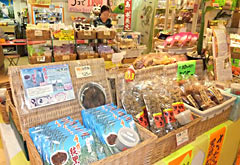Production of brown sugar affected by poor sugar cane harvests

Chunks of brown sugar run short because of cuts in output. May 7, Kokutoya, Naha.
May 8, 2012 Fumitaki Jahana of Ryukyu Shimpo
2011 to 2012 was a lean season for sugar cane in Okinawa. The shortage of raw materials led to a decrease in production of chunks of Okinawan brown sugar, which in turn pushed the selling price up. The problem of short supply came after the over stock of the previous year was resolved. A branding campaign was carried out from April in conjunction with the tightening of labeling requirements of origin for chunks of brown sugar, and officials commented, “The increased demand for chunks of Okinawan brown sugar means that these production cutbacks have caused significant losses in potential business.”
One of the main factories, Tarama, which is owned by Miyako Sugar Manufacturing, also reduced its production significantly to 1946 tons from the previous level of between 3500 and 3700 tons. According to a spokesperson for the company, the average price of chunks of brown sugar has risen by 30 yen compared to that of the previous season, which was 230 to 235 yen for 30 kilograms. JA Okinawa, which operates five factories in Okinawa, also had its price go up 10 yen from the average, with the wholesale price becoming 230 yen.
Markets have been affected by this increase in wholesale prices. Kokutoya, a specialty shop selling chunks of brown sugar increased the price by about 20 to 30 yen per 100 grams for almost all of its commodities. Kokutoya company president Masami Aragaki said, “A labeling system has just started. Cuts in production at this stage were not what we expected. We may need to be flexible and reduce the proportion of molasses to use as sugar. I think we can somehow meet market demand.”
Last year, the Okinawa Products Associated Co. Ltd. exported 20 tons of brown sugar chunks to Taiwan and Hong Kong. An official said, “Demand exceeds supply.” On a weight basis, there is ten times more demand than supply, but supply is only about 10% of that of last year. The official said, “We have been affected by natural disasters, but the cut in output has affected confidence in our ability to supply market needs. Availability of raw material is crucial in our business. The introduction of the labeling system drove up demand, so this is a double whammy for us. We really hope that next season will be better.”
(English translation by T&CT, Shinako Oyakawa and Mark Ealey)
Previous Article:Students from Hikone City Nishi Junior High School have their school song by Baku
Next Article:Ryukyuan indigo dyeing introduced at Japan Festival Paris
[Similar Articles]
- Brown sugar day
- En Group to expand brown sugar exports to Hong Kong
- Processing of sugarcane starts – lowest output since Okinawa’s reversion
- Sugar production season kicks off in Okinawa
- Odac boosts sales of Okinawan mushrooms to Taiwan
 Webcam(Kokusai Street)
Webcam(Kokusai Street)


